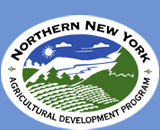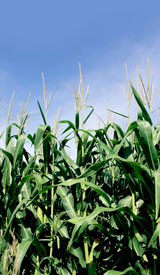October 1, 2009
Contacts: see list at end
Northern NY Grower Testing New Varieties of Apples
Chazy, NY - New varieties of apples are the rage this fall and
third-generation apple grower Donald F. “Tre” Green III of Chazy is
among orchard owners harvesting both new and traditional varieties.
Green has provided land at his 1,300-acre Chazy Orchards for the New
York Farm Viability Institute-funded field project that directly engaged
growers with evaluating new varieties of apples bred at Cornell
University’s NYS Agricultural Experiment Station. Over the past century,
Cornell has developed 62 new varieties.
Green says, “It used to be there were four or five varieties of apples
to choose in the store. Today, there are twenty and the next hot
specialty grabs the shelf space.”
A third-generation grower, Green has grown 12 trial varieties with the
potential to be NY’s next “big apple.” He calls his Northeastern New
York location “the most severe apple-growing climate in New York state”
to test the new apple selections. The varieties selected for testing at
his orchards were judged as having the highest percentage for success.
“Out of the twelve, you hope one or two will pay off, but maybe none
will, maybe ten will,” Green says.
He defines a successful apple as “medium to large, firm, crisp, with a
unique flavor, from a grower-friendly tree that requires little pruning
and low spray with branches well-angled for growing fruit not wood.”
Green has not forsaken the traditional McIntosh apples, a perennial
favorite with consumers. That variety has been grown in Northeastern New
York since the late 1800s.
Green is a major exporter to Europe where McIntosh apples are not grown,
however, he says, “The United Kingdom is also especially open to new
varieties.”
He also supplies U.S. markets in New York, the Midwest, Florida and
Texas.
Project leader and Cornell University apple breeder Dr. Susan Brown
says, “Accelerated on-farm development of new apple varieties is needed
to meet constantly changing consumer demand.”
Brown adds, “If the expected new apples are even half as successful in
commercial orchards as their predecessors – the Empire, Jonagold, Macoun
and others, New York’s apple producers will harvest great fruit with a
tremendous economic impact.”
Green hopes the trial apples do as well as his last new variety.
“The Honeycrisp was an unknown when I planted it in 2000 and it has
proven to be perfect for our northern growing conditions and our
buyers,” Green says.
For more information on Cornell’s apple breeding program, contact Susan
Brown at Cornell University’s NYS Agricultural Experiment Station in
Geneva, NY, at 315-787-2224.
Learn more about growing apples, grapes, and other horticultural crops
in Northern NY by calling your local Cornell Cooperative Extension
office or check the Northern New York Agricultural Development Program
at www.nnyagdev.org #
Contacts:
Project leader: Susan K. Brown, Cornell University, 315-787-2224
Apple grower: Tre Green, Chazy Orchards, 518-846-7171
Cornell Cooperative Extension Horticultural Educators for Northern NY:
• Clinton County: Amy Ivy, Anne Lenox-Barlow, 518-561-7450
• Essex County: Anita Deming, 518-962-4810
• Franklin County: Carl Tillinghast, Richard Gast, 518-483-7403
• Jefferson County: Sue Gwise, 315-788-8450
• Lewis County: Michele Ledoux, Joe Lawrence, 315-376-5270
• St. Lawrence County: Steve VanderMark, 315-379-9192
Cornell Northeastern NY Commercial Fruit Program Tree Fruit Extension
Specialist: Kevin Iungerman, 518-885-8995
Northern New York Agricultural Development Program
Co-Chairs: Jon Greenwood, 315-386-3231; Joe Giroux, 518-563-7523
Website: www.nnyagdev.org
New York Farm Viability Institute:
www.nyfvi.org



